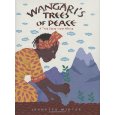In my Grade 1 and 2 classroom, it feels like we have been focused on writing for many months. Writing narratives and reports, using graphic organizers, and editing drafts into published pieces. The children have been “saying” and “showing” a lot, and as their energy is rising with the warmer weather, I think it is a good time for some “doing.”
A couple of weeks ago, our class was invited to watch a Grade 3 class present The Great Kapok Tree: A Tale of the Amazon Rain Forest. It just happened that we were enthralled with reading a book about saving trees too, Wangari’s Trees of Peace: A True Story from Africa. When we returned to our class to discuss the play we had watched, the children were inspired to create their own based on the book about Wangari. I realized that taking the opportunity to watch the Grade 3s perform was beneficial as they modelled for the Grade 1 and 2 class how a non-professional play looks.
Our current big idea is “How has the world changed?” with a focus on structures and movement (Science curriculum for Grade 1 and 2). The book, Wangari’s Trees of Peace is a text that lends itself to many other big ideas such as environmentalism, women’s rights, education, and world peace. When we read the book together for the first time, the students also saw its connection with the idea of hope, which was the inquiry question we started with back in September.
This project has revitalized our classroom. We wrote the story into a script format, dividing most of the story into parts that will be read by four narrators. Then we added a few lines for the characters. We discussed the scenes in the story and decided on three scenes. Children readily volunteered for parts in the play, to paint the background images, to create costumes, and to change the sets between acts. During our inquiry periods, I look around the classroom and see some of the children working on draft versions of the background settings, while others sit in pairs or groups practicing their lines and discussing the various roles.
Today, the narrators and actors read their parts in front of the class for the first time. I couldn’t help but notice how attentive the rest of the class was, as I thought their attention at the carpet was previously waning. They offered suggestions to the readers or actors and represented themselves as a community of learners. This play project emerged at just the right time in the year, when the children are comfortable enough with each other to take risks with acting and ready for a new challenge.
I am not sure how long it will take us to prepare for a presentation of the play, as I am learning along with the children. We plan to invite their parents and definitely the Grade 3 class that inspired us!



